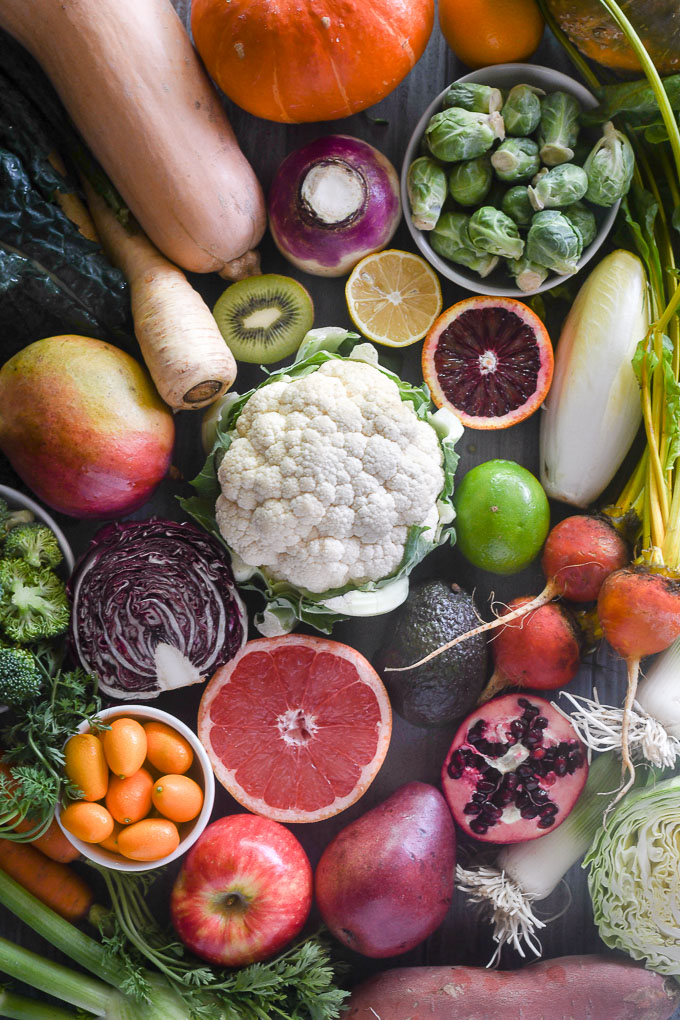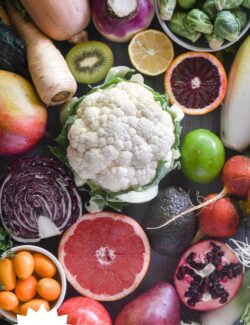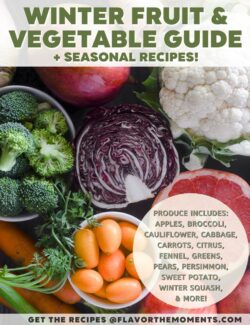Winter Fruits and Vegetables
There are so many varieties of delicious winter produce in season now, and you’ll find the complete list of Winter Fruits and Vegetables in this handy produce guide! You’ll find everything from broccoli, cauliflower, winter squash, citrus and sweet winter fruits, along with an array of recipes to inspire you to use them the all winter long!

The winter season may not come to mind first when you think about amazing seasonal produce, but it has a wide variety of colorful, delicious produce to offer that is often overlooked.
This winter produce guide outlines Winter Fruits and Vegetables that are in season now, including beets, broccoli, sweet potatoes, winter squash, citrus and an array of winter fruit, and how they can be incorporated into your recipes.
Years ago I embraced eating seasonally, and I’ve never looked back. I realized that when I eat what’s in season, I’m eating the freshest produce available as its more prone to be local, which means it also has a lot more flavor and it’s much more affordable.
Eating seasonally has also motivated me to try new produce that I would have typically overlooked for my favorite out-of-season fruits and veggies.
Now I look forward to the beginning of each new season because I can’t wait to start incorporating a new variety of produce into my meals!
Table of contents
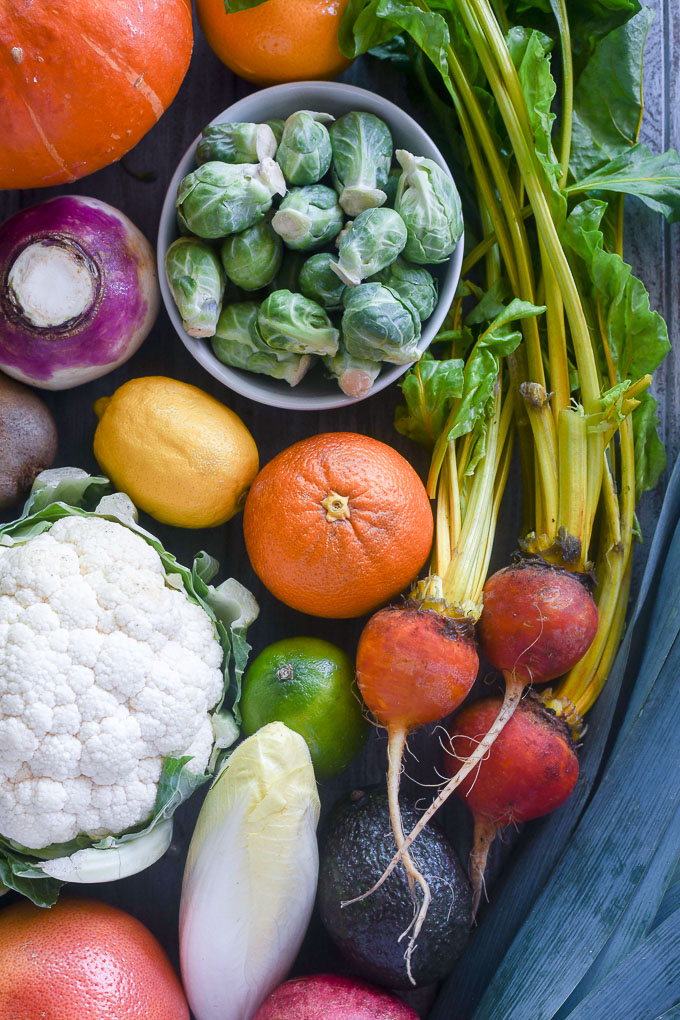
List of seasonal winter foods
Below is a handy list of seasonal winter foods that you can quickly refer to before you’re headed to the market.
Be sure to check out the detailed sections of winter veggies and winter fruits below to find out more, and access some tasty recipes!
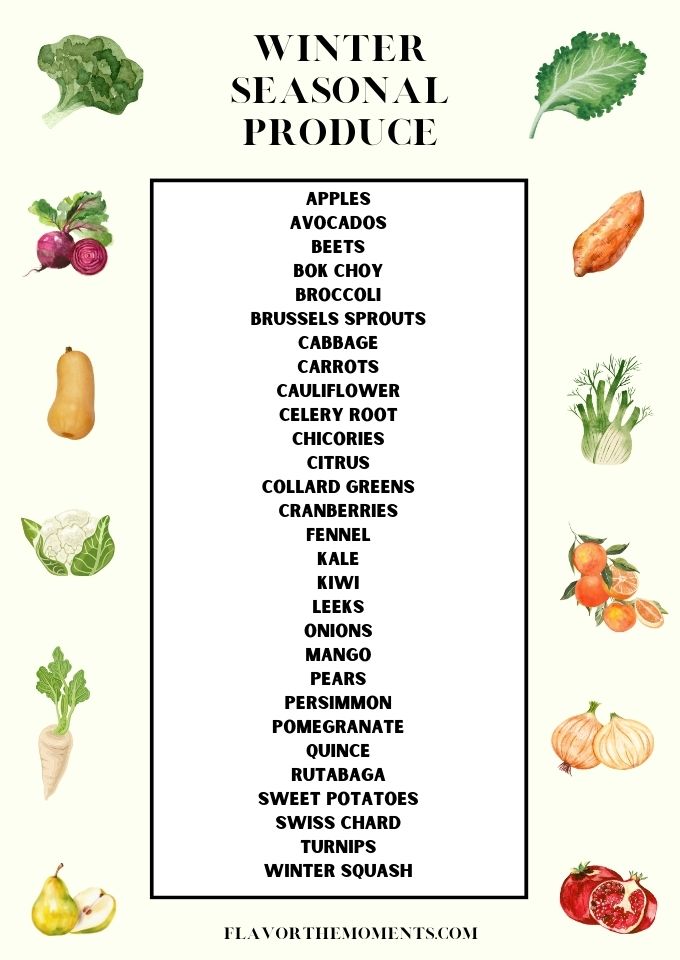
Winter Vegetables
There are a great variety of fresh vegetables in season in winter, so there’s no excuse not to eat your veggies! You’ll find a plenty of cruciferous vegetables, root vegetables, hardy greens and more.
The season for these winter veggies may be shorter depending on where you live, and availability will vary as well.
Avocado
While avocados are classified as a fruit from a botanical standpoint, they are predominantly used in savory recipes. They have a mild flavor and a smooth, buttery texture that’s quite luxurious.
While avocados are high in calories and fat, it is healthy monounsaturated fat and they’re cholesterol free. They are nutritional powerhouses packed with vitamins, minerals and fiber as well.
Uses: Avocados are great for avocado toast, in salads, dressings and dips, as a topping for burgers and sandwiches, or even hidden in desserts like chocolate mousse and brownies.
Seasonal swaps: There really is no substitute for avocado!
Beets
Also known as beetroot or garden beet, beets are a taproot vegetable that can be found in a variety of colors such as red, golden and chiogga, or candy-cane striped.
The flavor of beets is sweet and earthy, and they’re a good source vitamins, minerals, fiber and folate. And don’t forget the beet greens! They’re completely edible and packed with nutrition as well.
Uses: Beets may be eaten raw or cooked in salads, they’re amazing roasted (and even pickled), and the greens can also be sautéed or used in soups.
Seasonal swaps: Try sweet potatoes, butternut squash or parsnips for sweetness. For earthy flavors, try rutabagas, turnips or celery root.
Bok choy
Bok choy is a type of Chinese cabbage that has a mildly sweet flavor and peppery undertone. It’s a good source of Vitamins A, C and K, fiber and calcium.
Uses: Bok choy is very versatile and can be eaten both raw and cooked. It’s wonderful in stir fries and soups!
Seasonal swaps: Green cabbage is a great substitute for the crisp, white bulb of bok choy. Sub the bok choy greens with your favorite winter greens such as kale, swiss chard or collard greens.
- Sauté it in my shrimp fried rice or chicken vegetable stir fry.
- Ramen bowl by Foolproof Living
Broccoli
Broccoli is a member of the brassica family. It has a slightly earthy and cabbage like flavor that mellows when it’s cooked.
It can be eaten raw or cooked, and the stalks are completely edible as well though they may need to be cooked longer than the florets.
Uses: Broccoli is wonderful eaten raw in salads or with dips or dressings, and it’s also great roasted or used in quiche, soup and stir fries.
Seasonal swaps: Cauliflower in raw or cooked applications, brussels sprouts or cabbage in raw applications.
Brussels sprouts
Brussels sprouts are a member of the brassica family, and they are basically miniature cabbage that grows in clusters on a large stalk.
They’re small and firm with a cabbage flavor that mellows to sweet and nutty when they’re cooked.
Uses: They are shaved thinly and eaten raw in salads and they’re incredible fried, roasted and sautéed as well.
Seasonal swaps: Green cabbage is the closest in taste and color. Broccoli or cauliflower is also a good substitute.
Cabbage
Cabbage is a member of the brassica family, and it comes in many varieties, including green, red, savoy, napa cabbage and more. It has a sweet, peppery flavor that varies depending on the variety.
Uses: It’s great raw in salads and slaws, roasted, sautéed and is also great in soup.
See my handy cabbage produce guide and a complete collection of cabbage recipes for more information.
Seasonal swaps: Brussels sprouts are the perfect substitute for cabbage in both raw and cooked forms. Bok choy is a great substitute when cooked, or consider leeks or root vegetables such as turnips, rutabaga and parsnips.
Carrots
Carrots are long, thin root vegetables with bright green tops. They’re sweet and crunchy, and come in a wide range of colors such as orange, white, yellow and purple. The flavor varies based on the color that you’re consuming.
They’re a good source of Vitamins A, C and K, as well as fiber.
Uses: Carrots make a great raw snack served as-is or with hummus, and they’re great in salads. They are the foundation of french cooking as well as they’re an essential ingredient in french mire poix and stocks for their great flavor. They’re also wonderful roasted, added to soups and stir fries, and they make great desserts!
See my collection of carrot recipes, which is a produce guide that includes a multitude of information on carrots.
Seasonal swaps: Parsnips or are the best substitute for sweetness and texture, and beets work in some applications as well. Low carb alternatives for soups, stews or roasting are rutabaga, turnips or celery root.
Cauliflower
Cauliflower is a cruciferous vegetable that is a head of compact white florets. The florets have a mild, sweet flavor and it’s a good source of Vitamin C, fiber and potassium.
Uses: Cauliflower is extremely versatile and can be eaten raw with dips or in salads, or it can be steamed, roasted, mashed or sautéed. Riced cauliflower is widely used low carb alternative to traditional white or brown rice.
Seasonal swaps: Broccoli is the best substitute for texture, but has a slightly different flavor.
Chicories
Chicories are in the Asteraceae family, and are closely related to lettuces. They have a distinct bitter flavor in come in many varieties including frisée, Belgian endive, escarole and radicchio.
Uses: Chicories can be eaten raw just like lettuce in salads, while escarole and radicchio can be incorporated into soups or sautés. Radicchio is very hardy and may also be roasted or grilled.
See my collection of chicory recipes, which includes a produce guide that outlines a multitude of information on these fabulous vegetables.
Seasonal swaps: Good substitutes for chicories are bitter greens such as kale, Swiss chard, collard greens, etc., and green or purple cabbage depending on the application.
Fennel
Fennel is a bulbous, flowering plant that’s a member of the carrot family. It’s a very hardy, perennial herb with yellow flowers and feather-like fronds, or leaves and it’s completely edible.
It has a crisp, crunchy texture and mild sweet, anise flavor, and it’s a good source of vitamins and minerals including iron, magnesium, zinc, niacin, calcium, potassium, vitamin K and vitamin C.
Uses: Fennel is crisp and refreshing raw tossed in salads and slaws, and it has an amazing texture and mild flavor when it’s roasted.
See my collection of fennel recipes, which includes a produce guide that outlines a multitude of information on these fabulous vegetables.
Seasonal swaps: Celery, leeks or bok choy, depending on the application.

Kale
Kale is a hardy leafy green that’s a member of the cabbage family. It comes in a variety of colors from dark green to purple and even white, and the leaf textures can be smooth or curly.
Varieties include lacinato kale (also known as dinosaur or Tuscan kale), curly kale, red Russian kale, baby kale and more. Each variety has a distinct bitter flavor.
It’s widely used because of its health benefits. It’s a good source of vitamins A, C, and K, as well as fiber, calcium, and iron.
Uses: Kale is nice and hardy, and is great raw in salads because it won’t wilt down once it’s dressed. Tough leaves can be massaged with olive oil to soften them, which also mellows the flavor. It is also wonderful cooked in soups and stews or sautéed.
Seasonal swaps: Substitute kale with greens such as Swiss chard, mustard greens, dandelion greens or arugula.
Leeks
Leeks are vegetables in the Allium ampeloprasum family, which also includes varieties of onions and garlic. While onions and garlic form tight bulbs, leeks grow in long cylinder shapes comprised of bundled leaf sheaths or layers.
They have a very mild onion aroma and delicate flavor, and they’re a bit sweeter than regular onions. They’re high in Vitamin A, C and K, and are good sources of iron, calcium and minerals.
Uses: The white and light green parts can be used raw in salad for a mild crunch, and they’re great roasted or cooked in risotto, soups, stews and pasta. Don’t throw away the dark green tops as they are phenomenal for vegetable stock!
See my collection of leek recipes, which includes a produce guide with tons of useful information.
Seasonal swaps: For mild onion flavor, shallots are a great substitute. Pearl onions are also a good swap depending on the application.
Parsnips
Parsnips are root vegetables that belong in the flowering plant family Apiaceae, which also includes carrots, fennel and parsley. They are similar to carrots in texture when cooked, but their flavor is sweeter with mild earthy, woody notes.
They are an excellent source of potassium, Vitamins C and K and folate, and are a good source of Vitamins B6, E and riboflavin and minerals.
Uses: Parsnips have a crisp, crunchy texture and can be eaten raw. They’re fabulous roasted, puréed, cooked in soups and stews, and even baked in desserts.
See my collection of parsnip recipes for more information about this delicious root vegetable.
Seasonal swaps: Parsnips can be substituted with other root vegetables such as carrots, rutabaga, turnips depending on how you want to use them.

Potatoes
Potatoes need no introduction — they’re one of the most popular vegetable in the world. This starchy root vegetable is so versatile and comes in many varieties, including Yukon gold potatoes, red potatoes, fingerling potatoes and russet potatoes.
They’re soft and vary in texture from creamy and fluffy to waxy, and they’re a good source of Vitamin C, potassium and fiber.
Uses: Potatoes are not eaten raw, but they’re excellent cooked. They can be baked, fried, mashed, roasted, and cooked in soups and stews. And let’s not forget about those potato skins!
Seasonal swaps: Sweet potatoes can be swapped out for potatoes, although the flavor varies considerably. Parsnips, rutabaga, turnips and celery root are also good lower carb swaps.
Rutabaga
Rutabagas are a small root vegetable that’s very similar to turnips. They are green or purple on top with yellow or orange flesh, and they have a sweet, slightly bitter flavor.
They’re a good source of Vitamins A and C and fiber.
Uses: Rutabagas can be eaten raw or cooked. They’re great roasted and mashed, and are a wonderful addition to soups and stews. You can use them almost anywhere you use potatoes.
Seasonal swaps: Turnips are a good substitute in texture, though the flavor is much more mild. Potatoes and parsnips are a good swaps as well, though they are starchier and higher in carbohydrates.
- Add them to my Chicken Stew in place of potatoes.
Turnips
Turnips are a root vegetable in the brassica family. They are globe shaped with a purple top, and have either white or yellow flesh. The white flesh is more mild in flavor, and the yellow fleshed variety is slightly sweeter.
They’re a good source of Vitamin C, fiber and antioxidants.
Uses: Turnips can be eaten raw or cooked. They’re great roasted and mashed, and are a wonderful addition to soups and stews.
Seasonal swaps: Rutabaga is the best substitute for turnips. Parsnips and potatoes are starchier, higher carbohydrate substitute.
- Add them to my Irish beef stew in place of parsnips.
Sweet potatoes
Sweet potatoes are so wonderfully versatile and come in a variety of shapes, sizes and colors. They’re typically elongated and the color of the flesh can be orange, yellow, white or purple.
Some of the most popular varieties include Beauregard, Japanese, Jewel, Garnet, Hannah and Purple Stokes, and the flavor profile is sweet with a slightly nutty flavor.
Sweet potatoes are a good source of Vitamins A, C and E, fiber and potassium.
Uses: Sweet potatoes are great in both sweet and savory applications. They can be baked, boiled, fried, mashed and roasted. They’re great in soups and stews, puréed and used in casseroles, pies and cakes.
Seasonal swaps: Potatoes are a good substitute in texture but they are much milder in flavor. Carrots are a better substitute in flavor.
Swiss chard
Swiss chard is a leafy vegetable related to beets. Chard has long, dark green leaves and the stems vary in color from white to yellow, pink and red.
The flavor of chard is slightly bitter when it’s raw, but it mellows once its cooked. It has a slight earthy, metallic flavor similar to beets.
Chard is an excellent source of Vitamins A, C and K, as well as fiber, iron and other minerals.
Uses: Swiss chard is great raw in salads or even in pesto sauce. It is also delicious sautéed or added to soups and stews.
See my collection of Swiss chard recipes along with a multitude of other information.
Seasonal swaps: Kale, collard greens and mustard greens are great swaps. Spinach and arugula are good swaps in a pinch.
- How to make pesto sauce (with any greens)
- Sautéed Swiss chard
- White bean stew
Winter squash
Winter Squash is a variety of gourds that are generally harvested in the fall and are available for months. They come in many varieties including acorn squash, butternut squash, delicata squash, kabocha squash and spaghetti squash.
Each type of winter squash is a good source of vitamins, minerals and fiber.
- Acorn squash. Small and dark green in appearance with a mildly sweet, nutty flavor when roasted.
- Butternut squash. Long and beige in color with bright orange flesh that’s sweet and velvety. See my collection of butternut squash recipes for more information.
- Delicata squash. Small and oblong in shape, and ranges in color from white, yellow and orange with dark stripes. The flesh is light orange in color and it’s flavor is sweet and nutty. See my collection of delicata squash recipes for more information.
- Kabocha squash. Dark green and resembles a pumpkin. Flesh is bright orange with a sweet, nutty flavor and velvety texture. See my collection of kabocha squash recipes for more information.
- Spaghetti squash. Spaghetti squash is much different from other winter squash in that it “shreds” into long strands similar to spaghetti or noodles. Its flavor is sweet, earthy and very mild, making it a versatile ingredient.
Uses: Acorn and delicata are great roasted and stuffed. Butternut and kabocha are great roasted or mashed, and can be used in soup and stews. Spaghetti squash is a great low carb replacement for pasta!
Seasonal swaps: Acorn, butternut, delicata and kabocha squash can pretty much be used interchangeably. There really isn’t an adequate substitute for spaghetti squash.
- Butternut squash risotto
- Butternut squash soup
- Fall harvest salad (use any roasted squash!)
- How to cook spaghetti squash
- Mashed butternut squash
- Roasted delicata squash by Two Peas and Their Pod
- Roasted kabocha squash
- Stuffed acorn squash by Paleo Running Momma
- Spaghetti squash lasagna

Winter fruits
There are so many amazing winter fruits to choose from as you’ll see in the list below. The beautiful variety of citrus is sure to brighten up your winter, right along with persimmon, pomegranate, mango and more.
The season for these winter fruits may be shorter depending on where you live, and availability will vary as well.
Apples
Apples are one of the most popular fruits in the world. The phrase “an apple a day keeps the doctor away”, may have something to do with it, but their flavor and versatility definitely sets them apart.
They’re addictively crisp and juicy, and have a sweet, tart flavor that varies depending on the variety you choose. Popular varieties include Fuji, Golden Delicious, Granny Smith, Honeycrisp, Pink Lady and Red Delicious.
Apples are a great source of fiber, Vitamin C and potassium, and are a good source of minerals and antioxidants as well.
Uses: Apples are wonderful eaten raw as-is, dipped in nut butter for a snack, or even covered in caramel. They’re also a great addition to salads. When cooked, they can be mashed into applesauce and they’re incredible in pies, crisps, muffins and more.
See my collection of apple recipes and produce guide which lists more information on the different varieties and how to use them.
Seasonal swaps: Pears are the best substitute for apples.
Citrus
Citrus truly brightens up the dreariest winter day with its vibrant color and bright flavor. There are a number of different varieties to choose from, and they range in flavor from tart to sweet.
All varieties are an excellent source of Vitamin C, and are also good sources of fiber, potassium and other minerals.
- Clementines, mandarins and tangerines. These fruits resemble small oranges, they’re easy to peel, and are sweet and juicy with a slight tangy flavor.
- Grapefruit. Large in size with a tart, sweet flavor, and they vary in color from yellow to pink or reddish-pink. Varieties include Pink, Ruby Red and White. White is the tartest in flavor.
- Kumquats. Tiny in size, light orange in color and come in a plastic container at the store. They can be eaten whole and pack a unique tart-sweet flavor. The sweet, floral flavor comes from the peel, while the inside flesh delivers the tart flavor.
- Lemons. Lemons are medium sized, oblong in shape with a bright yellow color, and are tart in flavor. Meyer lemons are rounder in shape, orange yellow color, and have a sweeter flavor that is a cross between a lemon and an orange.
- Limes. Limes are small and round, dark green in color and have a tart flavor. Key limes are much smaller in size with a delicate tart, floral flavor.
- Oranges. Larger in size than clementines, mandarins and tangerines, and not as easy to peel. They’re bright orange with a sweet, juicy flesh. Blood oranges are another variety that are smaller in size and orange red in color.
- Pomelo. Looks like an oversized grapefruit — it’s the largest citrus in the world. It has a very thick, white pith but the flesh is sweet, juicy and mild in acidic flavor.
Uses: Citrus can be eaten fresh, juiced and enjoyed as a beverage or in smoothies, or used in both sweet and savory dishes to add bright, acidic flavor.
- Citrus salad
- Key lime pie
- Lemon bars
- Lemon curd
- Lemon dijon baked salmon
- Lime curd
- Orange cream smoothie
- Pico de gallo
- Wild rice salad
Seasonal swaps. Each variety of citrus can be used interchangeably, although the flavor profile will have an affect on the overall flavor of your dish.
Cranberries
Cranberries are small, hard and deep red in color, and have a very tart flavor. They’re a great source of Vitamin C, they’re rich in antioxidants, and are a good source of fiber.
Uses: While they can be eaten raw, they’re quite tart. That said, they’re great in salsa and relish. They make great dried fruit which works perfect in salads, and they can be candied as well. They can also be juiced, cooked in sauces, or baked in pies, muffins, cakes and more. They’re great in both sweet and savory recipes.
See my collection of fresh cranberry recipes for more ideas and useful information.
Seasonal swaps: Pomegranate is a good substitute for cranberries in salads. Raspberries or tart cherries are the best substitute for baking, but since they’re not in season I suggest using frozen.
Kiwi
Kiwi, or kiwifruit, are round and “fuzzy” little fruits with a vibrant green color and tiny black seeds. They have a sweet, tangy flavor and are a great source of Vitamins C and K, as well as fiber.
Uses: Kiwis are phenomenal in winter fruit salad, smoothies, or used as a topping for quinoa oatmeal or breakfast fruit tarts.
Seasonal swaps: Clementines, mango or orange are good swaps, but the flavor will definitely vary considerably.
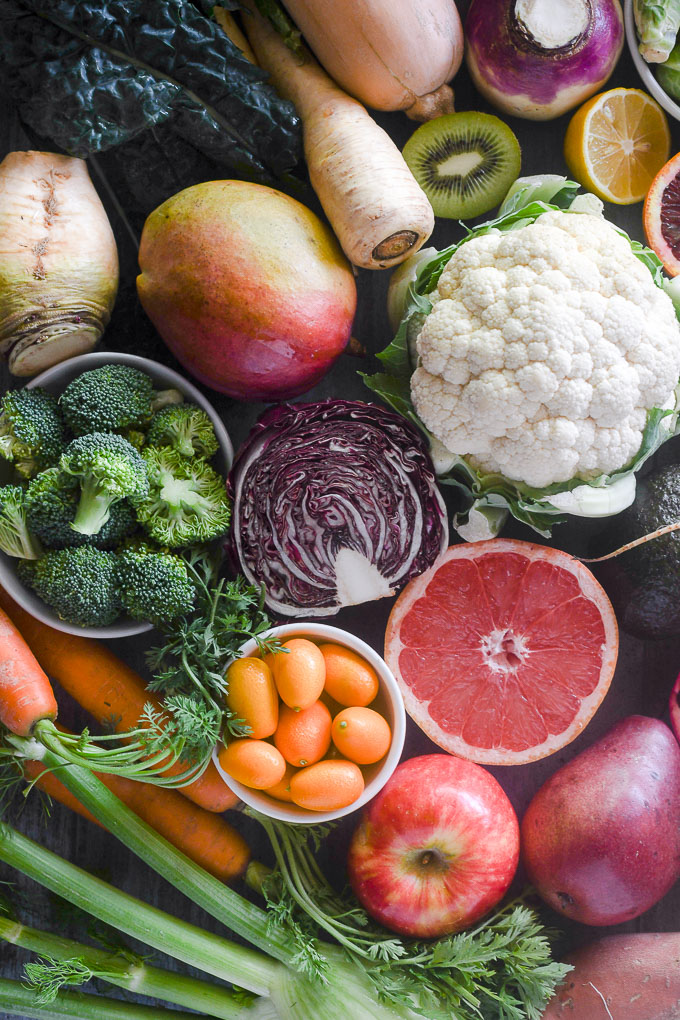
Mango
Mango is generally oval in shape and varies in color from dark yellow to a combination of orange, green and red. They’re very sweet and juicy with tropical, floral flavors.
They’re a great source of Vitamins, A, C and K, as well as antioxidants.
Uses: Mango are great eaten raw, added to smoothies or juiced. They can also be added to salsas, salad, desserts and more.
Seasonal swaps: The best winter swaps for mango are oranges or persimmon, depending on the application.
Pears
Pears are a member of the Rose family along with apples and plums. There are a wide variety of pears, and they vary in shape, color and texture.
Varieties include Angou, Asian, Comice, Bartlett (yellow and red), Bosc and Packham. They’re all sweet and juicy, and a good source of vitamins, minerals and fiber.
Uses: Pears can pretty much be used any way you use apples. They’re great eaten fresh as-is or added to salads. They make great sauce, and they can be baked into crisps, pies, muffins and more.
Seasonal swaps: Apples.
Persimmons
Persimmons are small, orange fruits that come in two widely used varieties. Fuyu persimmons are small and round, and is crisp like an apple, with a sweet, floral flavor. Hachiya is oblong in shape, and is very astringent in flavor when raw unless it’s very soft and squishy. Once ripe, it has the same flavor as Fuyus.
Persimmons are a good source of vitamins, minerals and antioxidants.
Uses: Persimmons are very versatile! Fuyu persimmon can be eaten raw when crisp and added to salads. When both fuyu and haciya persimmons are very soft, they’re great for jams, sauces, smoothies or purée them for muffins, breads, cakes and more.
See my collection of persimmon recipes, which includes a handy produce guide outlining tons of information about this special fruit.
Seasonal swaps: Apples, oranges or pears are the best substitutes, depending on the application.
Pomegranates
Pomegranates are deep red in color with crunchy, tart-sweet arils that resemble ruby colored jewels. They add a festive touch to any dish that they’re a part of.
They’re a good source of Vitamin C, potassium, folate and other minerals.
Uses: Pomegranates are great eaten fresh and make a great addition to salads and salsas, toppings for yogurt and oatmeal, or garnishes for desserts. They can also be juiced and made into molasses.
See my collection of pomegranate recipes for more recipe inspiration as well as useful information on choosing and storing them and more.
Seasonal swaps: Pomegranates are incredibly unique, and there really isn’t a great fresh substitute.
Quince
Quince is a fruit that is similar in appearance to a pear. It’s the same shape but much larger, it’s bright yellow in color, but it is very hard in texture.
It is tart and astringent when raw, but when cooked, it has a sweet flavor similar to apples and pears, with subtle floral and tropical notes.
It’s an excellent source of fiber, and is a good source of Vitamin C.
Uses: Quince is , but it’s great poached or cooked in jams, jellies, marmalades and pies.
Seasonal swaps: Apples and pears.
- 10 Quince recipes by Martha Stewart
